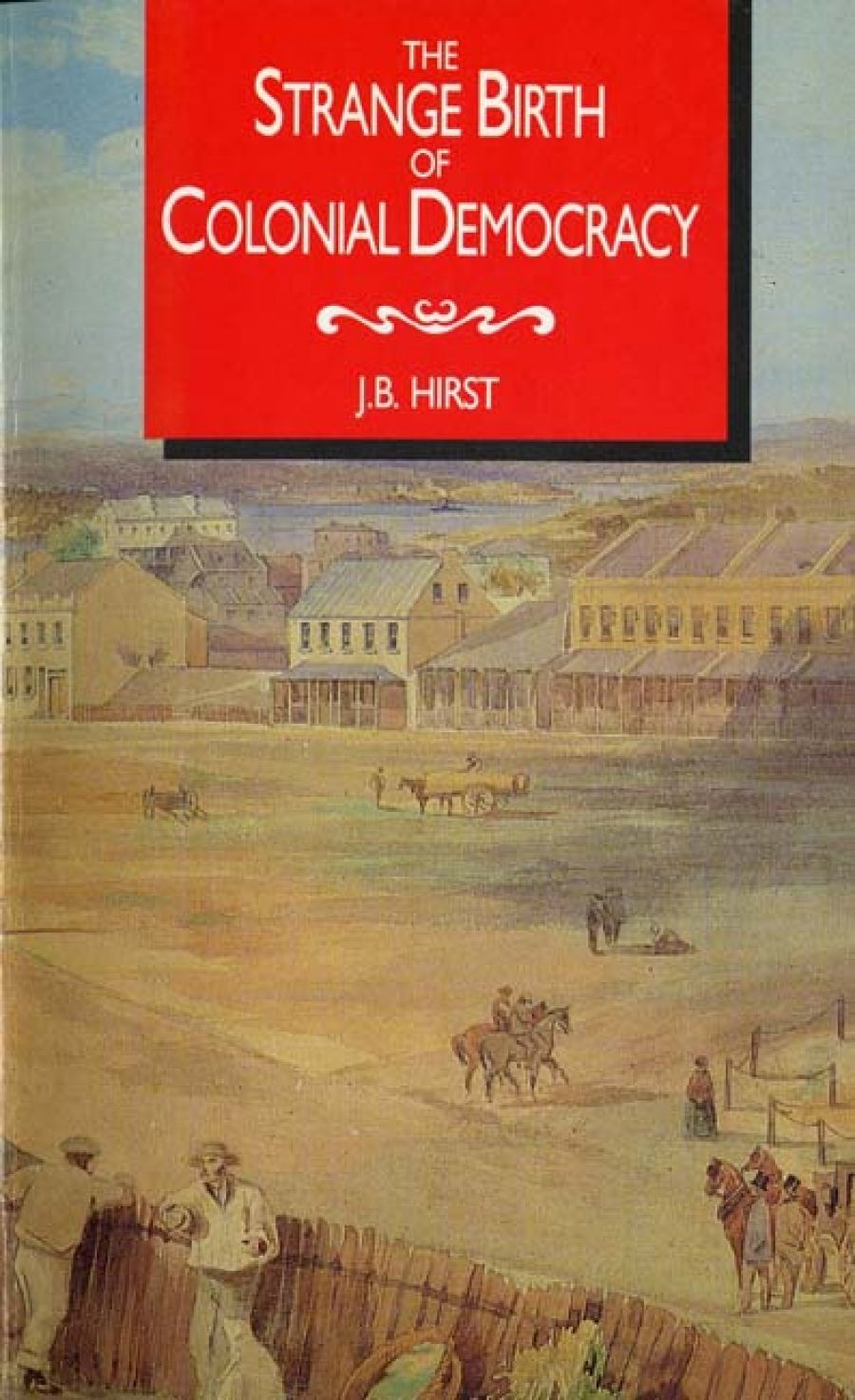
- Free Article: No
- Contents Category: History
- Review Article: Yes
- Online Only: No
- Custom Highlight Text:
In some ways, John Hirst presents his tale of colonial New South Wales as if it were a book for today. In the preface he comments: ‘But why should we care what it was like? – because in many fundamentals this is the political world we still inhabit.’ This theme is sketched and hinted at several times in the text but it is never argued in a systematic and rigorous manner. What are we to make of the claim?
- Book 1 Title: The Strange Birth of Colonial Democracy
- Book 1 Biblio: Allen & Unwin, 305 pp, $19.95 pb
Consider this. One of the most potentially interesting chapters in the book is called ‘Making Britain Democratic’. This is an account of the image of Britain constructed and used by the ‘democrats’ in urging reform in the colony. Hirst comments that Parkes ‘had worked wonders with the signs, and in a colonial society they had become more important than the substance’. He also notes that, in Britain, ‘The conservatives held up one Image – the glorious constitution of our fatherland – and Parkes eclipsed it with another.’ Even though this chapter pays more attention to the reformers than to those opposing them, a consideration of the construction and use of such ‘images’ in political mobilisations should have alerted Hirst to the difficulties and the importance of the task which he was hinting at. What image of the past has he sought to construct, what is his claim about continuity, what is his purpose in announcing the ‘fundamental’ similarities?
To put Hirst’s ‘fundamentals’ into place it is important to remember that this period is the one before effective party organisations had been created either within parliament or as means of popular political mobilisation. The development of a social democratic political movement (combining trade unions with parliamentary representation) had not been completed and understanding the fundamentals of our present political world would be impossible without a consideration of these two factors. Compared with these the consequences of the passage to forms of adult suffrage and representational politics are of secondary significance. They add an emphasis and a flavour to the evolution of the institutions and practices of New South Wales politics, but they did not determine them.
One of the themes of the book is the decline from civilised and gentlemanly virtues that came from political reform in New South Wales and the decline in the honour of a political life. Clearly, a continuity and relevance can be built out of this. The conservative critique of the push for democratic reforms and its revulsions can well be carried from one century to another, from one constellation of social forces to another. The process decried is not unravelled sufficiently to catch the variations in the citizenry of the condemned.
As for the ‘liberals’ who came to dominate politics – in what sense were they liberals? Where are their fundamental continuations in the present day? In the politics of a ‘new right’? In the Howard faction of a Liberal Party? In the Keating mentality of cuts and service to business in a right-wing Labor Party?
Hirst’s previous two books, Adelaide and the Country and Convict Society and its Enemies, were marked by their innovative and original approaches to their topics and by a skilled use of a variety of conventional and unconventional sources. These virtues are not so obvious in his latest publication. The sources are conventional and the argument is a familiar one, though not so clear in terms of the Australian example, at least not in the twentieth century. The book describes the people who argued for and against ‘democratic’ reform and the circumstances in which this was achieved, not as the result of a vast, self-conscious, popular agitation but as an offshoot of other forces and political considerations, as a normal and incidental part of colonial rule.
All the possible connections between economic, social and political positions are lightly sketched. The role of property, the role of the state in defining and securing property rights and the political form are given relatively less emphasis. Throughout the book the significance of the state (of government, the judiciary, and police) and the political system as a form of rule is not adequately probed. What did ‘democracy’ in New South Wales do to the wealthy? Was their economic position and prosperity seriously undermined? How did the state manage the problems of migration and access to land so that the calls to overthrow the ‘squatocracy’ did not achieve their aims? Only some aspects of this key theme concerning ‘private property’ are discussed: when writing of politics Hirst tends to put it into the context of the decline rather than in terms of consequences of state action for the definition and protection of essentially ‘private’ property.
There is some really good material and argument in The Strange Birth of Colonial Democracy. The last section, which deals with democracy and authority, and especially the chapter on the administration of the gold fields stand out as an account of the form of authority created in this context and the development of a form of democratic manners in Australian culture.
I like the fact that this book has a strong, clear point of view. I regret that Hirst did not enter the fray in all the contested areas of interpretation but remained content to present the tale in as much a narrative and thematic way as possible.


Comments powered by CComment